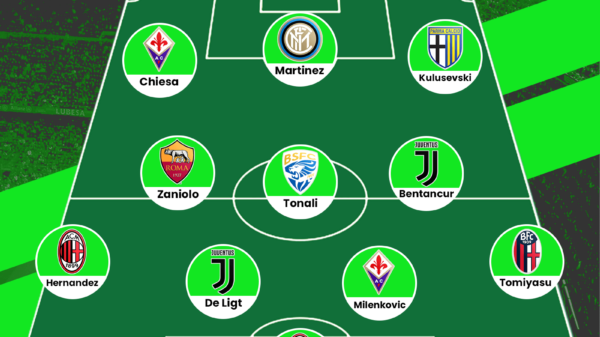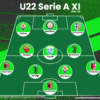James Sutherland provides a tactical analysis of the Coppa Italia final which finished Milan 0-1 Juventus.
The Coppa Italia final is always an interesting tactical match, if not usually entertaining. This match, unsurprisingly, was no different. Juventus, on the back of an amazing Serie A campaign that saw them go 26 unbeaten after an awful start, were expected to run away with the match. However, Milan put up a good fight, exploiting Juve’s weaknesses, and very nearly won the match.
MILAN 0-1 JUVENTUS
Lineups

Made using Tactical Pad
Milan (4-3-3): Donnarumma; De Sciglio, Romangnoli, Zapata, Calabria; Poli, Montolivo, Kucka; Bonaventura, Bacca, Honda
Juventus (5-3-2): Neto; Evra, Chiellini, Barzagli, Rugani, Lichtsteiner; Pogba, Hernanes, Lemina; Mandzukic, Dybala
Juventus were missing several key players, including Buffon, Bonnuci, Marchisio and Khedira. These absences hurt Juventus, especially in their build up play, where Max Allegri’s men struggled all night.
Juventus’ Build Up Issues
Juventus struggled for most of the game in build up play. This was for two reasons.
The first was the missing of key personnel. Buffon, Bonnuci and Marchisio are key to Juve’s build up play, especially Bonnuci and Marchisio. Allegri’s Juve use 3 at the back during build up play, usually Bonnuci in the center with Chiellini and Barzagli on either side.
This serves to build an overload in the first line of play, a good positional play principle. Teams cannot pressure the Juve backline well, because of the numerous options to play out of pressure. There are always three passing options: to another center back, into midfield (either the center or the wing, depending on which center back has the ball) or back to Buffon in goal.
The three at the back has the classic La Volpe move built into (where a central midfielder drops between the two center backs, who push wide). It is a fantastic structure for build up, and given Bonnuci’s ability on the ball, it gives Juve great versatility. They can play direct, with Bonnuci or Marchisio in the pivot playing long balls to Dybala or Pogba in the front line; they could also play direct through the wingbacks, who also overload the midfield and attacking line. Juve can also hold possession and build slowly, with a strong midfield presence.
Marchisio has been fantastic in the pivot this season, adjusting well into Pirlo’s old role. His partnership with Bonnuci is crucial to Juve’s success and stability in offense.
Without either, though, Juventus struggled offensively. Barzagli played in the center of defense, and lacked Bonnuci’s offensive abilities. Hernanes took Marchisio’s role, as he has at other times this season, but he was poor in possession, and couldn’t start counter attacks very well.
Juventus suffered a loss both of directness and build up from the loss of Bonnuci and Marchisio. Without their two main playmakers, Juventus build up was easily contained by Milan. Much of the build was forced to the wings, where Evra and Lichtsteiner struggled.
They also couldn’t force the ball directly to the front line. Neto in goal doesn’t have the distributing ability of Buffon, and Buffon’s accurate goal kicks were missed. The center backs and Hernanes were also poor in distribution, failing to start counters quickly enough. Dybala and Pogba weren’t given enough of the ball and quickly enough.
Milan’s Press and Counterpress
The second reason Juventus struggled in offense was Milan’s brilliant defense. Chrisitan Brocchi saw the potency of Juve’s back three, and decided to counter the overload with a 3 man frontline.
This allowed Milan good ball access and pressure in the first line of Juve’s build up. It was a risky decision, however, since Juve’s wingbacks could have fallen back and created a 5 v. 3 overload. Hernanes could also have dropped into the backline, or Juve could have used Neto better in possession. However, Milan got away with the risks, because Juve’s personnel didn’t adapt well, and Milan were able to stifle Juve’s offense.
Here you can see Milan’s 4-3-3 clearly. It puts good pressure on the back three, but Milan is incredibly stretched as well. The intensity and fitness it took to keep up the defense eventually wore Milan down, but for much of the game Milan were fantastic.
Deeper in the field, Milan would defend in a 4-2-3-1 or 4-2-2-2. They retained good pressure on the center backs, while limiting access to Hernanes in the center of the field. Both fullbacks also had the freedom to step up, countering potential overloads from Juventus’ wide midfielders and wingbacks.
Milan also ran a surprisingly effective counterpress. Their offensive structure, in a rough 4-3-3, transitioned well into pressure, and allowed Milan to cut off Juventus’ counterattacks before they could start.
Allegri’s Substitutes
Allegri, recognizing Juve’s offensive problems and lack of possession, decided to not fight against the stream and instead go with it. He took off Evra and Lichtsteiner, two wingbacks more built for possession, for Alex Sandro and Juan Cuadrado. Both Sandro and Cuadrado were more versatile and quick, allowing for better counter attack. However, Juve ceded possession. The strategy ended up working better, as Milan were drawn deeper into Juve’s half. Milan was also worn down as the game went on, and lost the capacity to counterpress well.
Allegri brought on Alvaro Morata as his last sub in extra time. It was the ultimate counterattacking sub, and it reaped immediate benefits. Just a minute after coming on, Morata finished off a brilliant counter attack, started deep in Juve’s half.
Conclusion
This game was much closer than anyone expected. Milan can be very proud of the match they played. Their defense was fairly good, although it had structural issues, and the offense did a good job retaining possession and creating chances.
Juventus were much worse than hoped, but that was less due to tactical issues and more to personnel ones. Although they eventually got the win, Allegri won’t be too happy with how they did it. Juventus are still the best team in Italy, however, and are set up to make great progress in Europe next season.
Written by James Sutherland
- Tactical Analysis: Sevilla 2-1 Real Madrid | Sevilla finally end the unbeaten streak - January 21, 2017
- Tactical Analysis: Borussia Dortmund 8-4 Legia Warsaw | Defence thrown out of the windows - November 27, 2016
- Tactical Analysis: RB Leipzig 1-0 Borussia Dortmund | Leipzing outpress Dortmund - September 18, 2016



























































